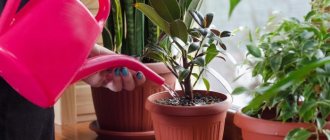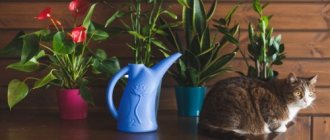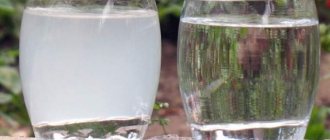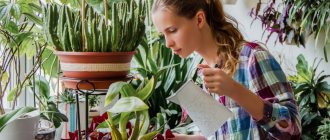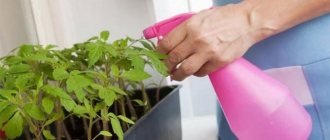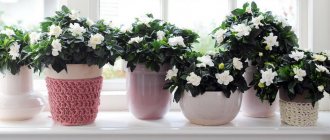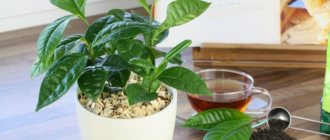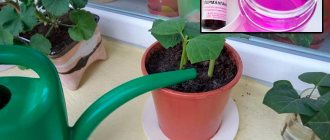The frequency and nature of watering indoor flowers largely determines how quickly they will grow, how luxuriantly they will bloom, as well as the degree of their susceptibility to certain diseases. Another “point” is the dependence of the amount of watering on the season.
It is unlikely that the information that watering houseplants in the warm season is fundamentally different from watering in winter can be called a secret. However, in order to provide your flowers with the liquid they need, more specific information is required.
Why do you need to water flowers at home?
First, you need to understand why watering indoor plants is necessary. Plants need water for various reasons. Firstly, it is the main component of tissues: some plants, primarily herbaceous ones with soft stems, consist of up to 90% water.
Water also has a nutritional function. The mineral salts contained in the soil are dissolved in it, and it carries them from the roots to the leaves of plants. Finally, water plays an important role in the respiration process: it evaporates through the stomata located on the underside of the leaves and humidifies the air surrounding the plant.
What happens if you don’t regularly water your indoor flowers? If a houseplant is not watered enough, then, as practice shows, the leaves and flowers become flabby and drooping, and the stems of herbaceous species fall off. Then the leaves wither and fall off.
In cacti and succulent plants, which usually contain a lot of water, with a lack of moisture, you can observe a clearly noticeable wrinkling of the entire plant.
But before, with the above-mentioned symptoms, you immediately grab a jug of water and water your indoor plants as much as possible, with all your heart, you need to think about the fact that excessive watering of house flowers, leading to excess moisture, is also harmful to crops, and the same symptoms appear the same as with a lack of moisture.
Why this happens can be explained simply: with excessive watering and spraying of indoor plants, all the pores in the soil that previously contained air are filled with water. In such a case, botanists talk about “stagnant waterlogging of the soil.” In such soil, which does not contain air, the root system can no longer function normally and absorb water. When houseplants are overwatered, the supply to the upper part of the plant stops, it dries out, while the lower part “sinks.”
You can find out how sensitively plants react to waterlogging and drying out of the soil from the recommendations for caring for individual species.
The next section of the article is devoted to how often you need to water indoor flowers, and by what factors you can distribute the level of water consumption.
What can be added to water for irrigation
When watering, you can use various nutritional supplements. Many housewives pour the water in which they boiled potatoes into pots. Starch is a good supplement, but only if you prepared the dish without salt. You can water with mineral water if it is not too saturated with salts. Keep the carbonated drink in an open container until all the bubbles come out of the liquid.
You can add 1 g of succinic acid to a liter of water; it is a good stimulator of plant growth and development. Although this substance is harmless and has a good effect on the immunity of indoor flowers, it is not necessary to use it more than 2 times a month. When replanting, you can immerse the roots in this solution; it stimulates the growth and development of all parts of the plant well.
When watering a flower with water and potassium permanganate, you will destroy the midges that appear from dampness. The same solution will help disinfect the soil in pots. Water with iodine is an excellent cure for fungal infections. All these components are not only a therapeutic agent, but also a source of essential microelements.
Don’t envy your neighbor, no matter what flower garden decorates her window. Establish proper watering of indoor flowers, do not forget about succinic acid and other useful additives. In a couple of months you can invite your friend to visit. Seeing your lush flowering bushes, she will not believe that there are ordinary geraniums and gloxinia on the window. Now let your neighbor be jealous that your flowers are better!
How often should you water indoor flowers: factors for water consumption by house plants
Precisely because there are no uniform recipes for properly watering home flowers, you should familiarize yourself with some basic rules, which are discussed below. They will help develop the sense of proportion necessary for watering.
How often you need to fertilize and when to replant crops can be determined exactly. But the frequency of watering depends on so many reasons that you will only find approximate information in books. You will learn whether the plant should be watered a lot or a little.
How often you need to water your indoor plants is determined by the following factors.
- Pot material. The same plant in a clay pot requires more water than in a plastic pot, as water evaporates through the porous clay walls.
- Pot size. A plant in a large pot needs more water than a plant in a small one.
- Location. On a southern window, plants most often require more water than on less lit eastern, western, and even more so northern ones.
- Temperature. Plants require more water in a warm room than in a cool room.
- Weather. On a hot summer day, the plant needs more water than on a cool and rainy day. In the heat, plant leaves evaporate more water, which means you need to water indoor flowers more often during this period, as experienced plant growers advise.
- Season. During the growing season (for most species, spring and summer), when plants form leaves and flowers, they require more water than during the dormant period (usually winter), when growth stops.
Next, you will learn about when to water indoor plants depending on soil moisture.
What determines a plant’s need for moisture?
The role of water for a flower is very great. Plant photosynthesis, nutrition, and reproduction depend on it. Proper watering of the plant will ensure good growth and lush, regular flowering. Root hairs, which are located on young roots, allow moisture to come from the soil and penetrate into the plant for subsequent transpiration. As for the need for moisture, it all depends on many factors:
- Condition of origin of the plant. The amount of liquid consumed directly depends on the type of flower and natural growing conditions. For example, a cactus does not need frequent moisture, like cyperus.
- The temperature of the room where the flower pot is located. The warmer the air, the faster all metabolic processes occur, which means the need for watering will be higher.
- Air humidity. The frequency of humidification directly depends on air humidity. The drier the atmosphere, the faster the leaves draw moisture from the roots, which means the flower needs to be irrigated more often.
- Illumination. Light affects photosynthesis. The brighter the lighting, the faster this process occurs. This means that more water is needed for active photosynthesis.
- Soil, substrate quality. For example, dense soil can lead to stagnant water, which is undesirable for some types of plants.
- Season. Indoor plants, like outdoor plants, are sensitive to the seasons. They bloom in spring and summer; in winter, some flowers go dormant, for example, violets. During active growth, watering should be maximum, during periods of calm - minimal.
- Pot volume. The size of the pot must match the dimensions of the root system. If there is not enough land, the moisture quickly evaporates from it and the plant feels bad.
When to water indoor flowers: time to water house plants
To correctly determine the time to water indoor flowers, you need to check the soil moisture. There are all sorts of ways to do this:
- The simplest method is to press your thumb into the ground about 1 cm from the surface. If your finger still feels moisture, then you can wait until watering.
- Pro Method (Clay Pots Only): Hold the pot in your hand and tap the side of the pot. If the clay rings, you need to water it. If the sound is muffled, it means there is still enough moisture in the ground.
- Technical method: Specially designed moisture meters are immersed in the ground. They will indicate when the soil is too dry.
Important! There are plants for which generally accepted laws regarding when to water indoor flowers do not apply. Such as Cyperus love constant dampness, and cacti can go without a drop of water for weeks. Along with the basic rules, we must not forget about the individual needs of plants.
If you are not yet sure about the right amount of water and frequency of watering, then you should start with plants that can easily tolerate excess moisture.
Below we describe how to properly water indoor flowers in winter.
Rare watering
Usually these are plants that grow in desert or semi-desert. The soil should dry out completely between waterings for such plants. This applies to all cacti, Crassula, Gavrotia, Sansevieria, as well as all bulbous and corm plants (gloxinia).
Determining the need for watering is quite simple. To do this, just look at the soil. Dry soil becomes lighter in color as it dries. It can be checked by touch. Or use special devices to measure soil moisture. There is also a method for determining the humidity in a pot with a plant. This is the weight of the pot and the sound the pot makes when you tap it.
In large pots or tubs, we determine the humidity not on the surface, but at a depth of 15 centimeters. This can be determined using measuring instruments or a stick. If there is still soil on the stick, then it is too early to water. Wait until the soil dries out a little more. In spring and summer, watering needs to be increased. And moisture-loving plants are watered twice a day (morning/evening).
Rules for watering indoor plants in winter
It is very important that you change your watering schedule around the end of September. At this time, most plants begin a dormant period when growth almost completely stops. Plants absorb less moisture from the soil. To avoid stagnant waterlogging, water much less frequently.
It is best to remember the three main rules for watering indoor plants in winter:
- Rule one. The colder the plant is in winter, the less it needs to be watered.
- Rule two. Watering at home those flowers that needed water daily in summer should be done once every three days in winter.
- Rule three. This is not the case with winter-blooming species such as azaleas (Rhododendron). Such plants require slightly more water throughout the flowering period.
The next section of the article is devoted to the best way to water indoor flowers so that they grow better and delight you with lush flowering in due time.
The best way to water indoor flowers: what water to use for watering house plants
In those days, when rainwater was ideal for watering indoor plants, this topic could be quickly closed. Today everything looks different. In most areas, what falls from the sky is more likely to harm indoor plants than to benefit them - rain contains so many harmful substances. So what kind of water should you water your indoor flowers so as not to harm your “green pets”?
If you still want to use rainwater, you should start collecting it half an hour or even an hour after the rain starts. Then it will contain less unnecessary impurities of foreign substances.
In terms of harmful compounds, tap water for watering indoor flowers is considered less problematic, but it also has one major drawback: it contains lime, and most plants cannot tolerate excess calcium. Water hardness is given in German degrees of hardness (°dH). In this case, 10dH means that 1 liter of water contains 1 mg of lime. You can find out the hardness of your tap water at a waterworks or have a water sample analyzed in a laboratory.
Water hardness up to 9 °dH does not cause problems for most indoor plants. Hardness between 9° and 12°dH can be reduced by settling or boiling the water. Water hardness above 12 °dH is undesirable for all plants.
If you know what kind of water to water your indoor plants, but the tap water in your home is too hard, you should definitely soften it, because not a single plant can tolerate high concentrations of lime. To do this, the following measures should be taken:
- When the hardness is between 10° and 12 0dH, it is enough to boil the water; in this case, lime is deposited in the form of plaque on the walls of the container.
- In stores you can buy jugs with ion exchange filters that soften water. Filters should be changed periodically.
- Liquid or powder water softeners are suitable for softening large volumes of water.
Knowing the best way to water your home flowers, you can extend the life of your home crops. And you can do without the old method of softening water using a bag of peat, so as not to reduce the already small reserves.
Below we describe how to properly water indoor plants in various ways.
Groups of plants according to moisture requirements
OVERWATERING
Some plants (azaleas, calamus, cyperus, etc.) need a very large amount of moisture in the substrate. From spring to autumn, water abundantly and frequently so that there is always water in the pan. In winter, watering is reduced slightly.
PLENTY WATERING
Inhabitants of the humid tropics and equatorial forests. From spring to autumn, the plant's substrate should be kept constantly moist, but without stagnant water.
In winter, indoor plants and flowers from equatorial forests (anthurium, dieffenbachia, calathea, arrowroot, spathiphyllum) are watered with a small amount of water after the top layer of 1-2 cm of soil mixture has dried.
And tropical plants tolerate drought well in winter (begonia, gloxinia, dracaena, monstera, ficus, hoya), so they are watered after the substrate has dried 1/2.
- This group includes most types of ornamental (lemon, ivy, etc.) and tropical plants (begonia, calathea, etc.).
MODERATE WATERING
Natives of the Mediterranean and humid subtropics. These indoor plants are watered 2-3 days after the substrate has dried to (1/5 of the pot) 3-4 cm deep.
- Such indoor flowers are watered abundantly in the spring-summer period, and moderately in the autumn-winter period. During the dormant period (October-March) water less frequently.
Indoor plants of the group have fleshy stems and leaves (peperomia), water-bearing tubers (asparagus, arrowroot), bulbous and with a powerful root system (aspidistra, dracaena, aroids, etc.).
In winter, some houseplants from the humid subtropics (aspidistra, ivy) are watered a little less than in summer, and most (clivia, chlorophytum, fuchsia, hoya) are also Mediterranean (laurel, myrtle, oleander).
RARE WATERING
Houseplants come from dry tropics and semi-deserts. They are watered actively during the growth period, and the rest of the time after the substrate has been dry for several days to several weeks during the dormant period.
- Plants of the group: hippeastrum, zygocactus, deciduous tuberous, bulbous, succulents.
In winter, semi-desert domestic plants (aloe, spurge, cactus) are watered once a month. And plants from a dry tropical climate (pineapple, balsam, sansivieria, Kalanchoe) are watered after half of the substrate becomes dry.
HOW TO WATER HOUSEPLANTS?
Methods of watering various types of plants and flowers are discussed in detail in a separate material - an addendum - at the top of this article.
Proper watering of indoor flowers and plants: bookmark reminder
- Before watering, make sure that the substrate is dry enough and the plant needs moisture.
- In the cold season (autumn, winter), water indoor flowers and plants in the morning so that the plant has time to use the moisture during the day and does not get too cold, and in the warm season - in the evening so that the moisture does not evaporate during the hot day.
- There must be a sufficient layer of drainage at the bottom of the pot.
- The higher the air temperature and lower the humidity, the more the plant needs watering.
- It is very important that the plant is watered consistently. Maintain approximately the same frequency of watering and the same amount of moisture supplied to the plants.
- Follow the golden rule: it is better to water more often and with less water than rarely and with more.
- After each watering of the plant, you need to loosen the soil mixture so that a crust does not form on its surface and the substrate remains moist longer.
Following these recommendations will ensure proper watering of indoor flowers and plants.
- What water is best to water plants and flowers?
- How can you tell if you are watering your plants with excessively hard water?
- How to make water softer?
- What temperature should the water be for irrigation?
These issues are discussed in detail in the supplementary material to this article.
What to do with a dried out plant?
It is better to restore a dried out plant or flower by immersing the pot in warm water (25-28°C) for 6-7 minutes.
The more dry the plant is, the longer you keep it in water until air bubbles stop escaping. After this, remove the plant and wait for the water to drain.
What to do with a flooded plant?
- First, the plant must be removed from the pot along with the earthen lump. Usually it is enough to knock on a hard object with the edges of the pot in a circle.
- After you take out the earthen lump, you need to cut off the rotten roots (if any) and wrap it with a piece of cloth (rag, old towel).
- Depending on the degree of moisture in the earthen ball, the fabric may have to be changed two or three times.
- Then the lump is wrapped in paper (blotting paper) and left in this form until it dries.
- After the coma has dried, it is better to transplant the plant into a new pot with fresh nutrient substrate.
We hope that now you know how to water indoor plants, and proper watering of indoor plants and flowers itself will become an easier and more understandable process.
We wish your flowers and plants to grow well and please the eye!
How to water house plants: methods of watering indoor flowers
Regular watering in small doses does not bring anything good to plants. In this case, water penetrates only into the top layer of the earth. The main part of the roots that absorb water is located in the lower third of the pot.
You need to water thoroughly. Most plants should be watered thoroughly - until the water comes out of the bottom hole - after about half an hour, drain the water from the pan again so that the plant does not get its feet wet.
It is important to monitor the water temperature. Ice water can shock most plants so much that the leaves wilt.
Ideal water is at room temperature, which corresponds to the temperature of the soil in the flower pot. Reaching this temperature is not a big problem: you just need to fill the jug in the evening for watering the next day. Overnight the water temperature will become equal to room temperature. A pleasant side effect: excess chlorine from the water will evaporate.
Watering time is also an important condition for normal plant growth. Water in the morning if possible. If you water in the evening, the soil and leaves will remain damp for a long time, which often causes fungal diseases.
There are two ways to water indoor flowers: from above or from below. Both methods have their advantages and disadvantages:
- Watering from below. If the leaves of a plant such as Saintpaulia ionantha cannot be wetted, if the plant does not like cold water, or if it grows outside the pot like Soleirolia soleirolii, then it is preferable to pour water into the tray of the pot. Together with water, fertilizer salts also rise to the top layer of soil, where they accumulate. Often a white coating appears on the surface of the earth after this. In such cases, you should periodically use the method of watering indoor plants from above or remove the top layer of soil substrate.
- Watering from above. With regular watering from above, directly onto the surface of the substrate, the soil is better saturated with moisture, and nutrients are distributed optimally. But at the same time, the water should be evenly distributed over the surface, otherwise depressions will quickly form through which the water flows without saturating the entire lump.
If there is a high lime content in tap water, it is better to water from above. In this case, lime binds in the upper layers and does not reach the roots of the plant at all.
How to water flowers in summer
In summer, most indoor plants develop intensively and need a lot of liquid. Make sure that the soil in the pots does not dry out. At this time, you can water with water containing nutrients: succinic acid, fertilizers, iodine, potassium permanganate. Remember that even the most useful component in large quantities is harmful, do not exceed the concentration of solutions:
- For 10 liters of water – 0.1 g of potassium permanganate.
- For 1 liter of water – 1 g of succinic acid.
- For 1 liter of water – 3 ml of iodine.
Advice
If you add a little hydrogen peroxide to the iodine solution, the composition can be used to treat plants affected by late blight.
There are plants that have a dormant period in the summer and active growth in the winter. You need to water them no more than once a week and make sure that the soil does not become too wet or turn into a completely dry lump. Find the coolest place in the house and put the pots there so that the heat does not prevent the flowers from resting properly. Do not under any circumstances add succinic acid, fertilizers or stimulants to the water.
We recommend: How to properly care for the graceful episcia
If you often leave your apartment for a week or more, do not make your pets suffer from thirst, choose some watering option without your presence. There are various devices for keeping the soil moist. Invest in a self-watering pot or drip watering system for indoor plants. When transplanting, add substrates to the soil that accumulate moisture and then slowly release it. If the business trip is urgent and unexpected, fill the trays with water; the soil will gradually draw it in through the drainage holes.
Rules for spraying indoor flowers at home
A type of additional provision of moisture to plants is spraying indoor plants with sprayed water. Spraying does not compensate for the lack of watering, and additional watering does not replace spraying.
Water is sprayed onto plants in order to increase humidity in the immediate vicinity of the leaves and thereby reduce evaporation. It is especially necessary to spray home flowers on hot summer days, as well as in winter in apartments with central heating.
For spraying indoor flowers, the same rules apply as for watering:
- Avoid irrigating plants in the midday heat; drops of water on the leaves turn into magnifying glasses and cause burns.
- When spraying house plants, do not spray ice water.
- If possible, use soft water with a low lime content, otherwise unsightly lime spots will appear on the leaves.
The flowers of some plants, such as azalea (Rhododendron) or pavonia, should not be wetted because they become unsightly.
Other plants with sensitive leaves, such as hybrid Saintpaulias (Sainpaulia ionantha), should not be sprayed at all.
Next, you will learn how to water indoor flowers that are too sensitive to lime.
How to water flowers sensitive to lime at home
If you have flowers that are sensitive to lime, they require special watering.
Azalea (Rhododendron simsii) . During flowering, bathe once every 2 weeks; do not spray flowers; put in a cool place; feed lightly; grow in non-carbonate soil.
Brunfelsia (Brunfelsia pauciflora) . Purple flowers bloom in late winter; cannot stand the sun; do not forget about the drainage layer; Do not spray the flowers - they become spotty.
Anthurium. It does not tolerate lime at all and is sensitive to increased concentrations of salts in the soil; take softened, heated water; feed lightly; do not spray the flowers.
Gardenia (Gardenia jasminoides). Wonderful, fragrant flowers; but a very sensitive plant; It blooms better if it is in a cooler place during the budding period; spray frequently, but not the flowers.
Camellia (Camellia) . Flowers range from white and pink to bright red, plain or interspersed; avoid temperature changes; in summer he likes to stand outside; Spray daily in winter.
Aglaonema. Similar to Dieffenbachia, but requires more care; does not tolerate direct sun; likes to always stay warm; needs high air humidity; plant in wide, low pots.
Calathea. A beautiful single plant with a distinctive leaf pattern; should be warm all year round; high air humidity and high soil temperature; loose soil; good drainage of the pot.
Usambara violet (Saintpaulia). Endless variety of colors, including two-tone, smooth or curly leaf edges, beautiful mini plants; do not spray leaves; Water only from below.
Araucaria (Agaicapa). Requires a lot of space to spread branches; do not place in bright sun; keep in a cooler place in winter; spray frequently; feed only lightly.
Bromeliads (Bromeliaceae) . These are attractive exotic plants that arrived in our apartments from Brazil.
All plants of this species, such as:
Aechmea
Neoregelia
Nidularium
They have some features that you should consider, and they will help you when caring for these plants.
Bromeliads form with their long pointed leaves, which are arranged in a circle, something like a funnel or rosette. It should be filled with water, depending on the type, all year or only during the growth period. It is recommended to update the water in the funnel approximately every two weeks.
Over- or under-watering indoor plants
It often happens every now and then that the plant receives too little or too much water. Before watering your houseplants, learn about what happens when you overwater or underwater.
Insufficient watering. If a plant's leaves or flowers fall off, the edges of the leaf blades become brown, and the leaves themselves look dull, then all these symptoms are signs of a lack of water. Rare watering of home flowers usually occurs during the owners' vacation. If you returned quickly and managed to react in time, then the plant can still be saved. A plant can dry out even when it is watered regularly, but never enough. In this case, the earthen lump dries out, a void appears between it and the walls of the pot, through which water flows down without even wetting the soil.
What to do? First, carefully loosen the top layer with a fork and press the soil with your hands to the edges of the pot. Then bathe: immerse the pot to the brim in a bucket of water and keep it there until air bubbles stop rising. At the same time, spray the above-ground part of the plant with water mist. After this, the plant is placed in a cool place. After half an hour, empty the pan of water!
Excessive watering. The first sign of excess water is the moss that covers the ground.
What to do? In such cases, it is often enough not to water the plant for several days and dry it slightly.
What to do in serious situations? It becomes difficult when spots appear on the leaves, the ground is thoroughly wet and smells sour - the roots are already rotting. In this case, you can try the following treatment:
- Spread a lot of newspapers in a shady place in the apartment;
- Remove the plant from the pot and place it on newspapers to dry;
- Only a few days later, after the soil has dried out somewhat, transplant it into the pot again;
- If at the same time you find brown tips of the roots, they should be cut off.
For indoor plants, you can buy very beautiful second pots made of ceramic or plastic everywhere, variegated and monochromatic, sometimes with attractive patterns. They often enhance the impression of flowers. But more than one lover of second potties has caused a lot of harm to their pets.
Second pots, no matter what, have one big drawback: water often accumulates in them unnoticed. As a result, up to half of the inner pot is in water, which causes stagnant waterlogging, which is unacceptable for the plant, because the roots rot, and soon the flower can be thrown away.
Check for water between the pots some time after watering. Place a layer of pebbles at the bottom of the outer vessel, on which you place the pot.
Signs of watering problems
If watering is inappropriate, the plants will immediately show the owner that they feel discomfort. How can you correctly understand that a flower is suffering from thirst?
- The leaves are falling.
- All green parts lose their elasticity.
- Buds and flowers quickly wither and fall off.
If you notice dangerous signs in time, the flower can still be saved. When the soil is too dry, it stops absorbing water and the liquid immediately spills into the pan. Simply watering a plant means doing nothing. Rinse it off from the shower and submerge the pot completely in water. To better absorb the liquid into the soil, pour 2-3 drops of liquid dishwashing detergent into it and mix well. Do not add any fertilizers or succinic acid, first let the plant recover. After about an hour, remove the pot from the water. When the soil dries, look to see if there are any gaps between the soil and the walls of the pot, and fill the voids with a nutrient mixture.
If you overdo it with watering, the following signs will indicate this:
- rot and mold appear on the above-ground parts;
- the ends of the leaves turn brown;
- the flower grows and develops poorly;
- the plant sheds its leaves, but in winter this is a natural phenomenon for some species.
It is urgent to take action before the plant dies. Remove the flower with the earthen lump from the pot, cut off the rotten roots. Wrap the soil in some fabric that absorbs water well or with toilet paper. Change the drying material from time to time. When the excess liquid has been removed, replant the plant in another container or old vessel, having previously disinfected it.
Indoor plants that love abundant spraying and watering
Now check out how to water flowers at home that love plenty of moisture.
Reed (Sdrpus cernuus). Light green ornamental grass; white flowers the size of a pinhead; no special requirements regarding location; there should always be water in the pan; spray frequently.
Hydrangea (Hydrangea) . Due to the large, soft leaves, the plant consumes a lot of water, especially in summer; use only softened water at room temperature; During the dormant period, water less.
Decorative asparagus, asparagus (Asparagus) . A well-known green element in bouquets; requires constantly moist roots in summer; In winter, water less, especially if the plant is in a cool place.
Indoor bamboo, pogonatherum . Refers to very thirsty plants; If leaves curl, water immediately; on hot days, spray frequently; There is always water in the pan.
Indoor calla lily (Zantedeschia). Comes from the swampy areas of Africa; during the period of growth and flowering, it requires a lot of water; from June to early August, water less; Requires a lot of light for flower development.
Syt (Cyperus) . Looks beautiful in aquariums too; like a marsh plant must always have its roots in the water; It tolerates heat in winter, but needs frequent spraying.
Watering indoor plants in the absence of owners: how to water house flowers during vacation
If you need to leave and there is no neighbor who could occasionally water the flowers, then you need to ensure that the plants are self-maintaining. This is possible, at least for some time.
Watering indoor plants in the absence of owners can be done using homemade water supply systems. The following methods have proven themselves well and do not require large expenses:
- Thick Strings: Arrange pots of flowers around a bucket or large pan of water. Take long lamp wicks or cotton threads and stick one end into the soil of the pots. The second end is lowered into the bucket. If the threads are pre-wetted, the flow of water will improve.
- A greenhouse made from a bag for plants that need high air humidity. A greenhouse from a bag will serve as an excellent option for moistening flowers during the holidays.
In specialized stores you can find a number of different systems for watering home flowers during the holidays. In any case, you should first check how long the water supply lasts.
A wet canvas is used to provide water to a large number of plants. The canvas can be placed on a surface next to the kitchen sink tank with one end of it in the water. Plants placed on a damp canvas can absorb moisture from it. The pots for this must be clay.
A clay cone for watering indoor flowers during the holidays can be recommended for single pots. It is filled with water and connected with a hose to the tank.
Plants that are left alone should be moved into the shade. Before leaving, you need to remove not only all withered and faded buds, but also all unopened buds.
If you want to save yourself from such problems with watering as too much or too little, today or tomorrow, you can transplant all your plants into pots with automatic water supply. They are containers with a double bottom where a reservoir of water is located. Through a wick or similar device, the plant itself takes in exactly as much water as it needs. Naturally, such a device only works as long as you remember to replenish your water supply. This must be done every 14 days. But for the period of a short vacation, your plant is provided with water.
The last section of the article is devoted to how to wash indoor plants.
Signs of improper watering
With a lack of moisture, the leaves of indoor plants become drooping and lethargic; in the case of hard, leathery plants, the leaves dry out and fall off, the flowers fade, and the buds fall off. Excess moisture is manifested by slow growth, falling of young and mature leaves, the presence of rot or brown tips, flowers and buds become covered with mold.
Is it possible to revive a dried out houseplant?
Overdried soil practically does not absorb water; it becomes slightly moist on the surface, flowing down the walls of the pot into the tray. An overdried earthen ball will moisturize watering well by immersing it in a container of water. But the plant, weakened by drought and lack of nutrients, will not cope with so much moisture at once; in wet soil, the roots will begin to rot and the flower will die.
Arbiz
Gradual hydration will allow the flower to recover and grow stronger. A wet sponge on the soil will allow it to gradually absorb moisture, releasing it to the soil as needed. Frequent spraying with mineral water from a spray bottle will help restore wilted leaves. Drip irrigation will allow you to absorb water as much as possible: a small hole is made in the lid of a plastic bottle into which a hose is inserted; a bottle with clean, settled water is closed with a lid with a hose, secured to some support with the neck down, the other end of the hose is wound around the trunk of the plant towards the ground.
Note! If gradual moistening does not help, then it is necessary to carefully remove the roots of the plant from the pot, evaluate their suitability and replant them in new soil, and then feed them with a small dose of mineral fertilizer.
It’s easier to protect flowers from drying out the soil in advance than to have to worry about resuscitating them later. Automatic watering and a layer of moisture-retaining materials under the soil, for example, floral foam (sponge), arbez or baby diaper filler, will help with this.
What to do if the flower is flooded
If a flooded plant is discovered almost immediately, a couple of leaves have fallen off or one of many branches has withered, and the soil is quite light, it is enough to loosen the soil well, opening up access to oxygen. If several symptoms of excess moisture are detected, an effective way of salvation is replanting in new soil. After removing the root system from the old pot, you need to inspect the roots for rot. Most often, rotten roots break off when extracted; if not, then they must be cut off. The sections are sprinkled with charcoal or sulfur powder. Next, the roots need to be dried for several hours in newspapers or a thick layer of toilet paper.
Orchid with rotten roots after flooding
After transplantation, the flooded flower is kept for at least a week in a warm, dark place. Do not water for 47-72 hours or fertilize for the first month and a half. After the expiration date, you can fertilize only with liquid formulations, for example, a decoction of banana skins. The transplanted flowers should be kept in high humidity for the first days; this can be done by placing the plant in a transparent bag, the edges of which are straightened and in no case tied.
Important! The transplanted plant can be watered with growth stimulants in the dark; if there are dark spots on the foliage, spraying with a fungicidal solution is recommended.
Soil moisture meter
A soil moisture meter for indoor plants will help you choose the optimal watering regime. This device allows you to estimate the amount of moisture at a certain depth. The fork of the device indicator is stuck into the ground 2/3 of the way. The arrow on the sensor will indicate “wet” or “dry”.
Proper watering of indoor plants is the key to active growth and flowering. Careful study and adherence to recommendations for caring for a particular crop will allow you to create your own greenhouse in the apartment.
